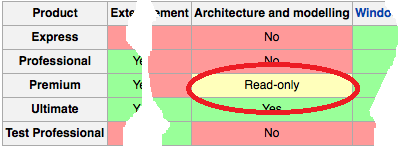June 5th, 2014
Abstract
The only way to edit architecture and modelling with Visual studio is to buy the very expensive Ultimate edition. This means that it will be not everyone can be involved in the process of evolving the solution.
TL;DR
Development requires Architecting an Architecture in some way or another. This architecture is not written in stone but changes as time or business changes; we call it requirements change.
In the old days, like 20 years ago, I learned that there is an architecture phase and then a development phase. This is not considered best practice any more. Also not best practice is to have silos with Architectures and Testers and Coders and Database managers.
This is where Microsoft and Visual studio fails. Not technically but license wise.
Look at this part of a comparison chart for different Visual studio versions. It clearly explains that Architects must have the Ultimate edition and that no one but Architects are allowed to change any Architect document. (the Ultimate edition is way more expensive than the others)

Visual studio comparison fail where it shows that only Ultimate can edit architecture stuff. Original from Wikipedia.
January 22nd, 2011
In short:
Fail.
A storage device with 3 single point of failure is a no no. Combine it with bad quality and it is a cheat.
Longer:
I cannot recall the exact name of the device but it was a 1TB NAS for about 300€ at the time, 3-4 years ago.
According to the specs it had an open source OS with two ordinary ext(2 or 3) discs. That sounded good for me. Open source OS meant that there was a possibility to tinker with it and knowledge out-in-the-world for discrepancies. Further if the hardware would fail I could always dock the disks into *nix machine and if one disc failed I could always get half the data from the other.
This was Totally wrong.
You see, Lacies support told me the OS was on one of the disks. So if a disk failed, the machine wouldn’t start. The machine was also setup in such a way that if the other disk failed nothing would start either. Finally the setup of the discs was in such a way that if removed from the device the data couldn’t be understood, Ext2/3 or not. To make the construction even worse, as if it wasn’t enough from the start, support told me that the disks and the OS and the machine was setup in the factory so there was no guaranteed way to get anything the disks runing in a new machine either.
I had it replaced with another unit that failed the same way. Incidentally a friend of mine had one too. It failed. He had it replaced. And the replacement failed again.
Having gotten 4 bad Lacie bigdiscs is possible as sheer bad luck. But the construction with 3 single point of failures is not coincidence.
